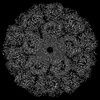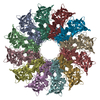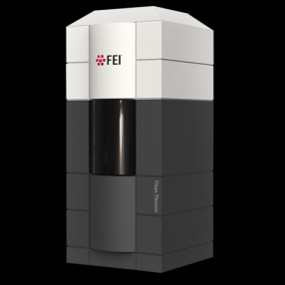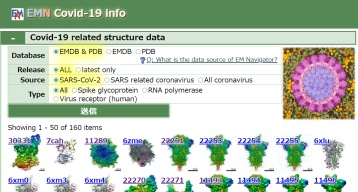+ Open data
Open data
- Basic information
Basic information
| Entry | Database: PDB / ID: 8fql | |||||||||
|---|---|---|---|---|---|---|---|---|---|---|
| Title | Portal vertex of HK97 phage | |||||||||
 Components Components | Portal protein | |||||||||
 Keywords Keywords | VIRUS / Prohead I / icosahedral symmetry / HK97 / phage / capsid | |||||||||
| Function / homology | Phage portal protein, HK97 / Bacteriophage/Gene transfer agent portal protein / Phage portal protein / symbiont genome ejection through host cell envelope, long flexible tail mechanism / viral capsid / Portal protein Function and homology information Function and homology information | |||||||||
| Biological species |  Escherichia phage HK97 (virus) Escherichia phage HK97 (virus) | |||||||||
| Method | ELECTRON MICROSCOPY / single particle reconstruction / cryo EM / Resolution: 3.6 Å | |||||||||
 Authors Authors | Huet, A. / Oh, B. / Maurer, J. / Duda, R.L. / Conway, J.F. | |||||||||
| Funding support |  United States, 2items United States, 2items
| |||||||||
 Citation Citation |  Journal: Sci Adv / Year: 2023 Journal: Sci Adv / Year: 2023Title: A symmetry mismatch unraveled: How phage HK97 scaffold flexibly accommodates a 12-fold pore at a 5-fold viral capsid vertex. Authors: Alexis Huet / Bonnie Oh / Josh Maurer / Robert L Duda / James F Conway /  Abstract: Tailed bacteriophages and herpesviruses use a transient scaffold to assemble icosahedral capsids with hexameric capsomers on the faces and pentameric capsomers at all but one vertex where a 12-fold ...Tailed bacteriophages and herpesviruses use a transient scaffold to assemble icosahedral capsids with hexameric capsomers on the faces and pentameric capsomers at all but one vertex where a 12-fold portal is thought to nucleate the assembly. How does the scaffold orchestrate this step? We have determined the portal vertex structure of the bacteriophage HK97 procapsid, where the scaffold is a domain of the major capsid protein. The scaffold forms rigid helix-turn-strand structures on the interior surfaces of all capsomers and is further stabilized around the portal, forming trimeric coiled-coil towers, two per surrounding capsomer. These 10 towers bind identically to 10 of 12 portal subunits, adopting a pseudo-12-fold organization that explains how the symmetry mismatch is managed at this early step. | |||||||||
| History |
|
- Structure visualization
Structure visualization
| Structure viewer | Molecule:  Molmil Molmil Jmol/JSmol Jmol/JSmol |
|---|
- Downloads & links
Downloads & links
- Download
Download
| PDBx/mmCIF format |  8fql.cif.gz 8fql.cif.gz | 684.3 KB | Display |  PDBx/mmCIF format PDBx/mmCIF format |
|---|---|---|---|---|
| PDB format |  pdb8fql.ent.gz pdb8fql.ent.gz | 553.3 KB | Display |  PDB format PDB format |
| PDBx/mmJSON format |  8fql.json.gz 8fql.json.gz | Tree view |  PDBx/mmJSON format PDBx/mmJSON format | |
| Others |  Other downloads Other downloads |
-Validation report
| Summary document |  8fql_validation.pdf.gz 8fql_validation.pdf.gz | 1.8 MB | Display |  wwPDB validaton report wwPDB validaton report |
|---|---|---|---|---|
| Full document |  8fql_full_validation.pdf.gz 8fql_full_validation.pdf.gz | 1.8 MB | Display | |
| Data in XML |  8fql_validation.xml.gz 8fql_validation.xml.gz | 116.1 KB | Display | |
| Data in CIF |  8fql_validation.cif.gz 8fql_validation.cif.gz | 174 KB | Display | |
| Arichive directory |  https://data.pdbj.org/pub/pdb/validation_reports/fq/8fql https://data.pdbj.org/pub/pdb/validation_reports/fq/8fql ftp://data.pdbj.org/pub/pdb/validation_reports/fq/8fql ftp://data.pdbj.org/pub/pdb/validation_reports/fq/8fql | HTTPS FTP |
-Related structure data
| Related structure data |  29392MC  8fqkC M: map data used to model this data C: citing same article ( |
|---|---|
| Similar structure data | Similarity search - Function & homology  F&H Search F&H Search |
- Links
Links
- Assembly
Assembly
| Deposited unit | 
|
|---|---|
| 1 |
|
- Components
Components
| #1: Protein | Mass: 47318.488 Da / Num. of mol.: 12 Source method: isolated from a genetically manipulated source Source: (gene. exp.)  Escherichia phage HK97 (virus) / Production host: Escherichia phage HK97 (virus) / Production host:  |
|---|
-Experimental details
-Experiment
| Experiment | Method: ELECTRON MICROSCOPY |
|---|---|
| EM experiment | Aggregation state: PARTICLE / 3D reconstruction method: single particle reconstruction |
- Sample preparation
Sample preparation
| Component | Name: Escherichia phage HK97 / Type: VIRUS / Details: Prohead I expressed from plasmid in E.Coli / Entity ID: all / Source: NATURAL | |||||||||||||||
|---|---|---|---|---|---|---|---|---|---|---|---|---|---|---|---|---|
| Molecular weight | Value: 17.7 MDa / Experimental value: NO | |||||||||||||||
| Source (natural) | Organism:  Escherichia phage HK97 (virus) Escherichia phage HK97 (virus) | |||||||||||||||
| Details of virus | Empty: YES / Enveloped: NO / Isolate: OTHER / Type: VIRUS-LIKE PARTICLE | |||||||||||||||
| Natural host | Organism: Escherichia coli | |||||||||||||||
| Virus shell | Name: Prohead I / Diameter: 500 nm / Triangulation number (T number): 7 | |||||||||||||||
| Buffer solution | pH: 7.5 | |||||||||||||||
| Buffer component |
| |||||||||||||||
| Specimen | Conc.: 10 mg/ml / Embedding applied: NO / Shadowing applied: NO / Staining applied: NO / Vitrification applied: YES | |||||||||||||||
| Specimen support | Grid material: COPPER / Grid mesh size: 400 divisions/in. / Grid type: Quantifoil R2/1 | |||||||||||||||
| Vitrification | Instrument: FEI VITROBOT MARK IV / Cryogen name: ETHANE-PROPANE / Humidity: 100 % / Chamber temperature: 293 K |
- Electron microscopy imaging
Electron microscopy imaging
| Experimental equipment |  Model: Titan Krios / Image courtesy: FEI Company |
|---|---|
| Microscopy | Model: FEI TITAN KRIOS |
| Electron gun | Electron source:  FIELD EMISSION GUN / Accelerating voltage: 300 kV / Illumination mode: FLOOD BEAM FIELD EMISSION GUN / Accelerating voltage: 300 kV / Illumination mode: FLOOD BEAM |
| Electron lens | Mode: BRIGHT FIELD / Nominal magnification: 75000 X / Nominal defocus max: 4000 nm / Nominal defocus min: 1000 nm / Calibrated defocus min: 1000 nm / Calibrated defocus max: 4000 nm |
| Specimen holder | Cryogen: NITROGEN / Specimen holder model: FEI TITAN KRIOS AUTOGRID HOLDER |
| Image recording | Electron dose: 60 e/Å2 / Detector mode: COUNTING / Film or detector model: FEI FALCON III (4k x 4k) / Num. of grids imaged: 2 / Num. of real images: 2909 |
- Processing
Processing
| EM software |
| |||||||||||||||||||||||||||||||||
|---|---|---|---|---|---|---|---|---|---|---|---|---|---|---|---|---|---|---|---|---|---|---|---|---|---|---|---|---|---|---|---|---|---|---|
| CTF correction | Type: PHASE FLIPPING AND AMPLITUDE CORRECTION | |||||||||||||||||||||||||||||||||
| Symmetry | Point symmetry: C1 (asymmetric) | |||||||||||||||||||||||||||||||||
| 3D reconstruction | Resolution: 3.6 Å / Resolution method: FSC 0.143 CUT-OFF / Num. of particles: 72945 / Num. of class averages: 1 / Symmetry type: POINT | |||||||||||||||||||||||||||||||||
| Atomic model building | Protocol: FLEXIBLE FIT / Space: REAL |
 Movie
Movie Controller
Controller






 PDBj
PDBj